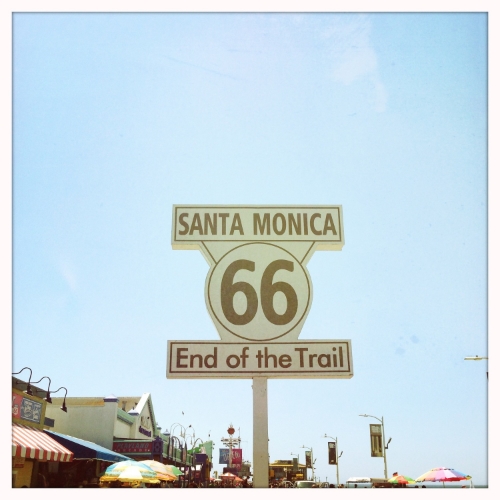I'm back after a long hiatus due to my being a brand new Mom!
Since I still haven’t figured out an alternative to being devoted to my son, I had to live with the status quo of my blog – until now.
Max’s entry in my life shifted all my priorities. His need for love and protection has awakened my innermost instincts. But I gradually became aware that I also owe you – my readers – a new entry in my blog.
So if you’ll excuse my snail-like speed, I’d like to offer you my third story.
I couldn’t leap too far from my favorite topic - Los Angeles.
What makes this entry special is what triggered it: I came across Moby’s blog (http://mobylosangelesarchitecture.com), a while ago, and I immediately I wanted to have an imaginary conversation with him.
So listen up, Moby :).
As many of us know, you are an architecture aficionado and a huge fan of Los Angeles.
You’re a transplant from New York, and by now a rather assimilated denizen of our city. You’re a knowledgeable lover of architecture and I can only guess that in Los Angeles you found a new life-rhythm that fed your creative muse - since the LA experience fundamentally opposes the New York lifestyle.
In your blog you talk in detail about the evolution that New York City has undergone from the 80’s until now, discussing the changes in what New Yorkers practiced and preached over time, as well. Cities can change… and so can their residents.
It’s borderline cliché easy to love a universal archetype city like Paris - a metropolis infused with such timeless architecture and beauty. It inspires romance at every turn, and brings out any dormant passion you might have lurking in your heart.
By contrast, loving New York or Los Angeles for the long haul – long past the immediate falling in love with a new city vibe – requires both conscious choice and commitment.
The universal mind agrees that to love Los Angeles takes patience and tolerance. I think that’s what has been asked of me, and I would fully advise opening your heart to those qualities, to whoever considers living here… You, Moby, did just that.
Angelinos are very happy to assimilate new comers. I think you would agree that ambitious people living in big, densely populated cities with diverse cultural dynamics and high expectations are very often tested, broken, or sorely tempted to flee “Gotham“, sizing down and cocooning in a more welcoming, smaller place with slower living.
NY is a city that has defeated many. You don’t see it that way, and neither do I. Like you, I live in LA because I’m looking for occasional epiphanies within its serial monotony.
What struck me while reading your blog was that we both love houses, we love looking for houses, talking about houses and we are dreaming about owning houses we see for sale.
I know you just purchased a dream place in our hood. Congratulations!!! http://www.nytimes.com/2011/04/28/garden/28moby.html?pagewanted=all&_r=0
Many artists were fascinated with Los Angeles and made it their mirror and canvas, before it was fashionable to do so… Some were realistic and raw, while others went beyond – into a dreamlike imagination.
We honor and are proud of having such artists living and creating in the city we love. Ed Ruscha and John Humble are two of my favorites: they romanced and were seduced by Los Angeles at a time where its great expanses were still undeveloped and the definition of bad traffic was more than five Model T’s on the road at the same time :)
John Humble’s unique talent is the blending of commercial and residential neighborhoods, the intertwined highways and nondescript neighborhoods in a seamless way.
Here are some glimpses of Los Angeles by John Humble and Ed Ruscha, two artists that portrayed both its beauty and ugliness, at the time, the world maybe didn`t see them before.
Left: Atlantic Blvd, 1965, by Ed Ruscha, gelatin silver print; Right: 6565 Fountain Avenue, 1965, gelatin silver print-both at the J.Paul Getty Museum
Los Angeles is its own place, it`s commonly known to unfold the red carpet for the movies, while New York has the reputation for unfolding its carpet for world class art. Its legendary museums are still front runners, Broadway- still the Temple of Musicals
Although Los Angeles has been diversifying in art galleries and temporary exhibits, concerts, musical events and various spectacles, one aspect I complain about is- the lack of more libraries and neighborhod coffee shops where you can get lost for the afternoon, chewing on some good reading.
Actually, there is one place everyone should check out: It`s called - The Last Bookstore in Downtown LA.
I wonder Moby, if there some coffee shops that you would suggest?
A widespread city creates a giant network, a mingling place for unique, driven souls, making it quite hard to find one’s identity when one first gets off the bus at Union Station J. As opposed to New York’s overbearing, madhouse daily grind one must accept to survive there, LA’s own brand of multicultural blend of identities enables a choice of a myriad paces of life one can adopt.
For the casual visitor, the lack of a singularly defined city center raises a subtle fear that living without a "nucleus” could make it hard to identify themselves.
In by-gone times, it was said that Los Angeles was the place where intellectuals went to ruin themselves.
Me? I’m grateful to be here every day… I, too, find hidden layers and new social interactions among the admixture of cultures, the maze of transit lanes, and the magnificently crisscrossed highways….
Los Angeles- “that bright, guilty place”, as Orson Welles called it….
Just like you, after traveling far and wide in the world, I discovered the art of living in Los Angeles.
































